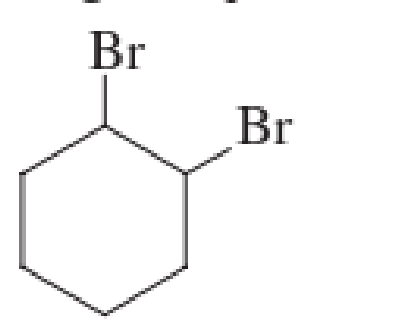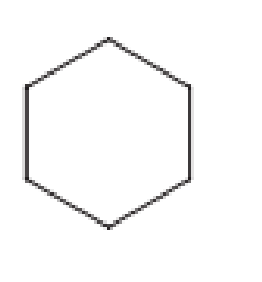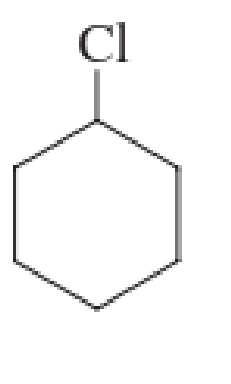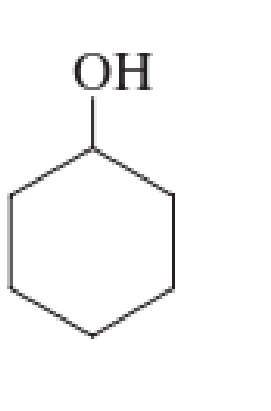
Bundle: General, Organic, and Biological Chemistry, 7th + OWLv2 Quick Prep for General Chemistry, 4 terms (24 months) Printed Access Card
7th Edition
ISBN: 9781305717534
Author: H. Stephen Stoker
Publisher: Cengage Learning
expand_more
expand_more
format_list_bulleted
Concept explainers
Textbook Question
Chapter 13, Problem 13.79EP
What reactant would you use to prepare each of the following compounds from cyclohexene?




Expert Solution & Answer
Trending nowThis is a popular solution!

Students have asked these similar questions
What alkane is needed as a starting material to prepare each of the following alkyl halides by a halogenation reaction?
The correct synthesis of octane would involve which of the following reactions?
Explain by the equation how cyclohexane can be obtained from benzene?
Chapter 13 Solutions
Bundle: General, Organic, and Biological Chemistry, 7th + OWLv2 Quick Prep for General Chemistry, 4 terms (24 months) Printed Access Card
Ch. 13.1 - Prob. 1QQCh. 13.1 - Prob. 2QQCh. 13.1 - Prob. 3QQCh. 13.2 - Prob. 1QQCh. 13.2 - Prob. 2QQCh. 13.2 - Prob. 3QQCh. 13.2 - Prob. 4QQCh. 13.3 - Prob. 1QQCh. 13.3 - Prob. 2QQCh. 13.3 - Prob. 3QQ
Ch. 13.3 - Prob. 4QQCh. 13.4 - Prob. 1QQCh. 13.4 - Prob. 2QQCh. 13.5 - Prob. 1QQCh. 13.5 - Prob. 2QQCh. 13.5 - Prob. 3QQCh. 13.6 - Prob. 1QQCh. 13.6 - Prob. 2QQCh. 13.6 - Prob. 3QQCh. 13.7 - Prob. 1QQCh. 13.7 - Prob. 2QQCh. 13.7 - Prob. 3QQCh. 13.8 - Prob. 1QQCh. 13.8 - Prob. 2QQCh. 13.9 - Prob. 1QQCh. 13.9 - Prob. 2QQCh. 13.10 - Prob. 1QQCh. 13.10 - Prob. 2QQCh. 13.10 - Prob. 3QQCh. 13.10 - Prob. 4QQCh. 13.10 - Prob. 5QQCh. 13.11 - Prob. 1QQCh. 13.11 - Prob. 2QQCh. 13.11 - Prob. 3QQCh. 13.11 - Prob. 4QQCh. 13.11 - Prob. 5QQCh. 13.12 - Prob. 1QQCh. 13.12 - Prob. 2QQCh. 13.12 - Prob. 3QQCh. 13.12 - Prob. 4QQCh. 13.12 - Prob. 5QQCh. 13.13 - Prob. 1QQCh. 13.13 - Prob. 2QQCh. 13.13 - Prob. 3QQCh. 13.14 - Prob. 1QQCh. 13.14 - Prob. 2QQCh. 13.14 - Prob. 3QQCh. 13.14 - Prob. 4QQCh. 13.15 - Prob. 1QQCh. 13.15 - Prob. 2QQCh. 13.15 - Prob. 3QQCh. 13.15 - Prob. 4QQCh. 13.16 - Prob. 1QQCh. 13.16 - Prob. 2QQCh. 13 - Classify each of the following hydrocarbons as...Ch. 13 - Classify each of the following hydrocarbons as...Ch. 13 - Prob. 13.3EPCh. 13 - Prob. 13.4EPCh. 13 - Prob. 13.5EPCh. 13 - Prob. 13.6EPCh. 13 - Prob. 13.7EPCh. 13 - Prob. 13.8EPCh. 13 - Prob. 13.9EPCh. 13 - What is the molecular formula for each of the...Ch. 13 - Prob. 13.11EPCh. 13 - Prob. 13.12EPCh. 13 - What is wrong, if anything, with the following...Ch. 13 - Prob. 13.14EPCh. 13 - Prob. 13.15EPCh. 13 - Prob. 13.16EPCh. 13 - Prob. 13.17EPCh. 13 - Prob. 13.18EPCh. 13 - Draw a condensed structural formula for each of...Ch. 13 - Draw a condensed structural formula for each of...Ch. 13 - The following names are incorrect by IUPAC rules....Ch. 13 - The following names are incorrect by IUPAC rules....Ch. 13 - Prob. 13.23EPCh. 13 - Prob. 13.24EPCh. 13 - Prob. 13.25EPCh. 13 - Classify each of the following compounds as...Ch. 13 - Prob. 13.27EPCh. 13 - How many hydrogen atoms are present in a molecule...Ch. 13 - Prob. 13.29EPCh. 13 - Draw a line-angle structural formula for each of...Ch. 13 - Prob. 13.31EPCh. 13 - Prob. 13.32EPCh. 13 - Prob. 13.33EPCh. 13 - Prob. 13.34EPCh. 13 - Prob. 13.35EPCh. 13 - Prob. 13.36EPCh. 13 - Prob. 13.37EPCh. 13 - Prob. 13.38EPCh. 13 - For each of the following pairs of alkenes,...Ch. 13 - Prob. 13.40EPCh. 13 - Prob. 13.41EPCh. 13 - Prob. 13.42EPCh. 13 - Prob. 13.43EPCh. 13 - Prob. 13.44EPCh. 13 - Prob. 13.45EPCh. 13 - Prob. 13.46EPCh. 13 - For each molecule, indicate whether cistrans...Ch. 13 - For each molecule, indicate whether cistrans...Ch. 13 - Prob. 13.49EPCh. 13 - Prob. 13.50EPCh. 13 - Prob. 13.51EPCh. 13 - Draw a structural formula for each of the...Ch. 13 - Prob. 13.53EPCh. 13 - Prob. 13.54EPCh. 13 - Prob. 13.55EPCh. 13 - Prob. 13.56EPCh. 13 - Prob. 13.57EPCh. 13 - Prob. 13.58EPCh. 13 - Why is the number of carbon atoms in a terpene...Ch. 13 - How many isoprene units are present in a....Ch. 13 - Prob. 13.61EPCh. 13 - Indicate whether each of the following statements...Ch. 13 - Prob. 13.63EPCh. 13 - With the help of Figure 13-7, indicate whether...Ch. 13 - Prob. 13.65EPCh. 13 - Prob. 13.66EPCh. 13 - Prob. 13.67EPCh. 13 - Prob. 13.68EPCh. 13 - Prob. 13.69EPCh. 13 - Prob. 13.70EPCh. 13 - Prob. 13.71EPCh. 13 - Prob. 13.72EPCh. 13 - Prob. 13.73EPCh. 13 - Prob. 13.74EPCh. 13 - Prob. 13.75EPCh. 13 - Write a chemical equation showing reactants,...Ch. 13 - Supply the structural formula of the product in...Ch. 13 - Prob. 13.78EPCh. 13 - What reactant would you use to prepare each of the...Ch. 13 - Prob. 13.80EPCh. 13 - Prob. 13.81EPCh. 13 - Prob. 13.82EPCh. 13 - Prob. 13.83EPCh. 13 - Prob. 13.84EPCh. 13 - Prob. 13.85EPCh. 13 - Prob. 13.86EPCh. 13 - Prob. 13.87EPCh. 13 - Prob. 13.88EPCh. 13 - Prob. 13.89EPCh. 13 - Prob. 13.90EPCh. 13 - Prob. 13.91EPCh. 13 - Prob. 13.92EPCh. 13 - Prob. 13.93EPCh. 13 - What are the bond angles about the triple bond in...Ch. 13 - Prob. 13.95EPCh. 13 - Prob. 13.96EPCh. 13 - Prob. 13.97EPCh. 13 - Prob. 13.98EPCh. 13 - Prob. 13.99EPCh. 13 - Prob. 13.100EPCh. 13 - Prob. 13.101EPCh. 13 - Prob. 13.102EPCh. 13 - Prob. 13.103EPCh. 13 - Prob. 13.104EPCh. 13 - Prob. 13.105EPCh. 13 - Prob. 13.106EPCh. 13 - Prob. 13.107EPCh. 13 - Prob. 13.108EPCh. 13 - Assign each of the compounds in Problem 13-107 an...Ch. 13 - Assign each of the compounds in Problem 13-108 an...Ch. 13 - Prob. 13.111EPCh. 13 - Prob. 13.112EPCh. 13 - Prob. 13.113EPCh. 13 - Prob. 13.114EPCh. 13 - Prob. 13.115EPCh. 13 - Write a structural formula for each of the...Ch. 13 - Eight isomeric substituted benzenes have the...Ch. 13 - Prob. 13.118EPCh. 13 - Prob. 13.119EPCh. 13 - Prob. 13.120EPCh. 13 - Prob. 13.121EPCh. 13 - Prob. 13.122EPCh. 13 - Prob. 13.123EPCh. 13 - Prob. 13.124EPCh. 13 - Prob. 13.125EPCh. 13 - For each of the following classes of compounds,...Ch. 13 - Prob. 13.127EPCh. 13 - Prob. 13.128EPCh. 13 - Prob. 13.129EPCh. 13 - Prob. 13.130EP
Knowledge Booster
Learn more about
Need a deep-dive on the concept behind this application? Look no further. Learn more about this topic, chemistry and related others by exploring similar questions and additional content below.Similar questions
- What is the structural formula of 1,3-dibromo-5-methylcyclohexane?arrow_forwardWhich one of the following compounds is a saturated hydrocarbon? Cyclohexene Ethyne Propene Cyclohexanearrow_forwardThe acid-catalyzed dehydration of 2,3-dimethyl-3-pentanol yields three alkene products. What are the names of the three alkenes? Which of the three alkenes is the major product?arrow_forward
- Alkyl sulfonates undergo the same type of substitution reactions as alkyl halides and can also be prepared from alcohols. What advantage does the preparation of an alkyl sulfonate from an alcohol have over the preparation of an alkyl halide from an alcohol?arrow_forwardWhich of the following acyclic compounds is an alkene with one double bond in its structure? C12H22 C11H22 C10H22 C6H10 C5H8arrow_forwardWhich of the following can be a molecular formula of an acyclic (this means no rings) hydrocarbon that contains one alkyne bond? C3H14 C8H16 C8H18 C3H20 C3H12arrow_forward
- The reaction of Hbr with 2-methylpropene produces 2-bromo-2-methylpropane. What is the structure of the carbocation formed during the reaction?arrow_forwardWhich alkane most readily undergoes thermal decomposition? Note that C-H bonds are usually stronger than C-C bonds. O ethane O dimethylpropane O propane O methylpropanearrow_forwardDescribe a sequence of reactions by which cis-2-pentene could be prepared from acetylene.arrow_forward
arrow_back_ios
SEE MORE QUESTIONS
arrow_forward_ios
Recommended textbooks for you
 Organic And Biological ChemistryChemistryISBN:9781305081079Author:STOKER, H. Stephen (howard Stephen)Publisher:Cengage Learning,
Organic And Biological ChemistryChemistryISBN:9781305081079Author:STOKER, H. Stephen (howard Stephen)Publisher:Cengage Learning, General, Organic, and Biological ChemistryChemistryISBN:9781285853918Author:H. Stephen StokerPublisher:Cengage Learning
General, Organic, and Biological ChemistryChemistryISBN:9781285853918Author:H. Stephen StokerPublisher:Cengage Learning Chemistry: Principles and PracticeChemistryISBN:9780534420123Author:Daniel L. Reger, Scott R. Goode, David W. Ball, Edward MercerPublisher:Cengage Learning
Chemistry: Principles and PracticeChemistryISBN:9780534420123Author:Daniel L. Reger, Scott R. Goode, David W. Ball, Edward MercerPublisher:Cengage Learning Chemistry: Principles and ReactionsChemistryISBN:9781305079373Author:William L. Masterton, Cecile N. HurleyPublisher:Cengage Learning
Chemistry: Principles and ReactionsChemistryISBN:9781305079373Author:William L. Masterton, Cecile N. HurleyPublisher:Cengage Learning Introduction to General, Organic and BiochemistryChemistryISBN:9781285869759Author:Frederick A. Bettelheim, William H. Brown, Mary K. Campbell, Shawn O. Farrell, Omar TorresPublisher:Cengage Learning
Introduction to General, Organic and BiochemistryChemistryISBN:9781285869759Author:Frederick A. Bettelheim, William H. Brown, Mary K. Campbell, Shawn O. Farrell, Omar TorresPublisher:Cengage Learning

Organic And Biological Chemistry
Chemistry
ISBN:9781305081079
Author:STOKER, H. Stephen (howard Stephen)
Publisher:Cengage Learning,

General, Organic, and Biological Chemistry
Chemistry
ISBN:9781285853918
Author:H. Stephen Stoker
Publisher:Cengage Learning

Chemistry: Principles and Practice
Chemistry
ISBN:9780534420123
Author:Daniel L. Reger, Scott R. Goode, David W. Ball, Edward Mercer
Publisher:Cengage Learning

Chemistry: Principles and Reactions
Chemistry
ISBN:9781305079373
Author:William L. Masterton, Cecile N. Hurley
Publisher:Cengage Learning

Introduction to General, Organic and Biochemistry
Chemistry
ISBN:9781285869759
Author:Frederick A. Bettelheim, William H. Brown, Mary K. Campbell, Shawn O. Farrell, Omar Torres
Publisher:Cengage Learning
Chapter 4 Alkanes and Cycloalkanes Lesson 2; Author: Linda Hanson;https://www.youtube.com/watch?v=AL_CM_Btef4;License: Standard YouTube License, CC-BY
Chapter 4 Alkanes and Cycloalkanes Lesson 1; Author: Linda Hanson;https://www.youtube.com/watch?v=PPIa6EHJMJw;License: Standard Youtube License